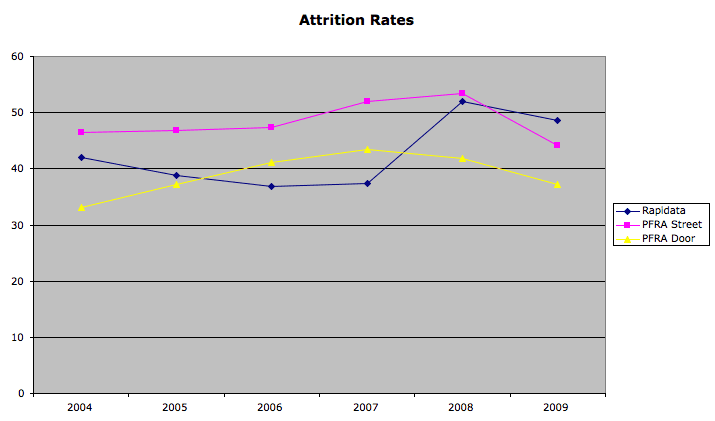Face to face attrition – a few thoughts
We have another chance to quantify the effects of the recession with the publication of the PFRA Face to Face Attrition Survey.
The study shows us what happened to those donors recruited on the street and door to door during 2009.
The figures look good.
- Average 1st year attrition for street campaigns fell back to 44.2% (from 53.3% in 2008). This is the lowest level of street attrition that the PFRA has ever recorded.
- Average 1st year attrition for door to door fell back to 37.2% (from 41.8% in 2008).
But the report leaves me asking a number of questions.
2009 was the height of the recession so I have difficulty believing the reference in the PFRA press release that the reduction in attrition rates is a post-recession phenomenon.
Let's start by comparing the PFRA figures to those released by Rapidata in their 2011 Direct Debit (DD) tracking report. As you'll see, 2009 is the first year where face to face techniques return a better attrition rate than that seen for (a massive percentage) of the entire UK DD universe.
When you take into account the fact that most DDs are cancelled in the first few months, it shows the PFRA figures in a very positive light. Something good is happening. But what?
Lets take it point by point…
Where are the no pays?
It doesn't look as though no pays have been included in the calculations (a no pay is a DD that doesn't result in a single gift). No pay rates have been increasing over the years. For example, back in 2004, face to face agencies recruited an extra 14% of donors at no charge (to replace no pays).The guarantee today is significantly higher.
The figures released by the PFRA show a first month attrition rate of about 11 or 12% – much lower than the current no pay rate. Add the two together and we may find about a third of all recruits are giving once – or not at all – before throwing in the towel.
If that's the case, the figures would still show an improving trend. They just wouldn't be so good.
It would be interesting to know what no pays actually are. Anecdotally I've heard that they are running at over 20%, but I'd like to have the actual figures to confirm.
What was the impact of the closure of Dialogue Direct?
Dialogue Direct was one of the UK's largest face to face recruitment agencies. It closed in 2009. As a result of this, the total number of people recruited via face to face techniques fell by 115,000 between 08/09 and 09/10. In one fell swoop there was much less pressure on the market and the remaining players could concentrate on recruiting at the best sites.
There would also be another positive impact on attrition. With many face to face recruiters out of work, there would be more competition for employment, with the cream of the recruiters rising to the top.
Did the 2008 jump in attrition rates frighten away the charities with less sophisticated fundraising programmes?
As the Fundraising Detective has pointed out, there is a huge disparity in attrition rates for different charities. If the charities with the worst attrition management campaigns were driven from the market, this would have a positive impact on overall cancellation rates.
Long time readers of this blog will know that I think the most important way of tackling face to face attrition is by improving stewardship programmes. I've blogged about how Buefrog tests have shown that personal treatment and a focus on impact reporting have dramatically improved face to face attrition rates.
It might be shocking but the fall in attrition could be down to the fact that we are getting better at communicating with younger donors?
Is there more focus on recruiting older donors?
On the other side of the coin, we've known for some time that the biggest infuence on attrition is age. Older donors are much more likley to keep their promises. Following the bad results in 2008 has there been more emphasis on avoiding students and the young unemployed?
Is there more focus on recruiting donors at lower gift levels?
The other major influence on attrition is gift amount. The higher the monthly gift, the more likley it is to be cancelled. If the 'ask' amount is dropped, attrition might also fall, but so does income. The result could be less attrition but also less money being raised.
Or is it down to something else?
I'm especially pleased that Adrian Sargeant is reviewing the figures. Hopefully he'll answer these questions and probably come up with a few insights that haven't occurred to the rest of us. That's one reason to look forward to the autumn when we'll see their publication.
Finally a big thanks to all those involved for taking the time and effort to share such great information. The rest of the fundraising profession could take a leaf from their book.
Tags In
Related Posts
3 Comments
Comments are closed.
The Essentials

Crack the Code to Regular Giving: Insights, Strategies, and a Special Giveaway!

‘Tis Halloween. Keep to the light and beware the Four Fundraisers of the Apocalypse!

Why do people give? The Donor Participation Project with Louis Diez.

A guide to fundraising on the back of a postcard

What does the latest research tell us about the state of fundraising?







You are right Mark, it is good to see that campaigns appear to be performing better in 2009 and we hope that this is a trend that will continue into 2010.
No shows are not included in the figures because not all charities were able to report out these figures when we started out in 2008 and we had to make the decision to run the report in the way that would allow for the majority of charities to take part.
We have done some analysis of no show rates and for 2009 the initial figures show the averages are 19% for the door and 10.4% for street.
Rupert and I are really looking forward to seeing the results that Adrian produces which should give us more insight into the many variables at work here.
Thanks for the mention Mark.
There was a bit of a discussion at the presentation about the effect of no shows and a couple of people were really frustrated they aren’t included.
Morag is probably being quite diplomatic above, as I get the impression she would love to include the no shows, but the data isn’t there. To be honest, I’m not sure how fundraisers can do their job properly without such information and it shows the lack of attention given to data in many fundraising teams.
My other (unproven) theory is the results are a little bit better than the reality, as the charities that report are likely to be the ones with the best data and attrition management. I’d imagine that
the true figure is higher and it’s a shame that more charities can’t take part, either through choice or a lack of accurate data.
I’d also love to see a breakdown of the attrition by recruitment agency, but not sure it would ever happen.
Finally, I did some rough calculations earlier to show the importance of attrition. The charity with the best attrition would raise 250% more than the one with the worst over five years (assuming the average gift is the same) – a massive difference and coming to hundreds of thousand pounds, but, as you say, there is still a reluctance to invest in donor experience and retention strategies.
Hi Morag and Craig
Thanks for the figures on no shows.
I’d also agree with Craig’s point regarding data reporting.
The argument for attrition management has surely been won now. I can’t see how charities can continue to ignore the impact of poor (or no) communications on face to face recruited donors.
Hopefully we’ll see even more improvement next year.
Mark